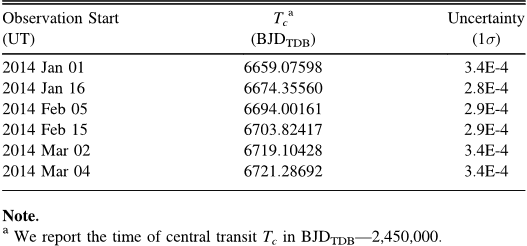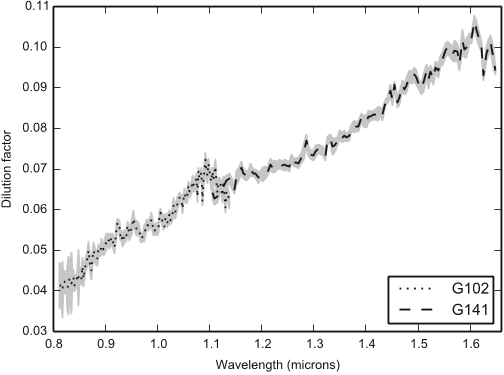A Detection of Water in the Transmission Spectrum of the Hot Jupiter WASP-12b and Implications for its Atmospheric Composition
Laura Kreidberg,Michael R. Line,Jacob L. Bean,Kevin B. Stevenson,Jean-Michel Desert,Nikku Madhusudhan,Jonathan J. Fortney,Joanna K. Barstow,Gregory W. Henry,Michael H. Williamson,Adam P. Showman +10 more
Reads0
Chats0
TLDR
In this article, a near-infrared transmission spectrum for WASP-12b based on six transit observations with the Hubble Space Telescope/Wide Field Camera 3 (HST-WFC) was reported.Abstract:
Detailed characterization of exoplanets has begun to yield measurements of their atmospheric properties that constrain the planets’ origins and evolution. For example, past observations of the dayside emission spectrum of the hot Jupiter WASP-12b indicated that its atmosphere has a high carbon-tooxygen ratio (C/O > 1), suggesting it had a dierent formation pathway than is commonly assumed for giant planets. Here we report a precise near-infrared transmission spectrum for WASP-12b based on six transit observations with the Hubble Space Telescope/Wide Field Camera 3. We bin the data in 13 spectrophotometric light curves from 0.84 - 1.67 m and measure the transit depths to a median precision of 51 ppm. We retrieve the atmospheric properties using the transmission spectrum and nd strong evidence for water absorption (7 condence). This detection marks the rst high-condence, spectroscopic identication of a molecule in the atmosphere of WASP-12b. The retrieved 1 water volume mixing ratio is between 10 5 10 2 , which is consistent with C/O > 1 to within 2 . However, we also introduce a new retrieval parameterization that ts for C/O and metallicity under the assumption of chemical equilibrium. With this approach, we constrain C/O to 0:5 +0:2 0:3 at 1 and rule out a carbon-rich atmosphere composition (C/O> 1) at > 3 condence. Further observations and modeling of the planet’s global thermal structure and dynamics would aid in resolving the tension between our inferred C/O and previous constraints. Our ndings highlight the importance of obtaining high-precision data with multiple observing techniques in order to obtain robust constraints on the chemistry and physics of exoplanet atmospheres. Subject headings: planets and satellites: atmospheres | planets and satellites: composition | planets and satellites: individual: WASP-12bread more
Figures

Table 2 Transit Times 
Figure 6. Systematics decorrelation parameters from the light curve fits plotted as a function of normalization c. We show (from top to bottom) the visit-long slope v, ramp rate constant a, ramp amplitude b, and ramp delay d. The normalization constant c is linearly proportional to the per-pixel flux in a spectroscopic channel. Measurements from the G102 and G141 data are shown in light and dark gray, respectively. The error bars indicate 1σ uncertainties from an MCMC fit to the light curves using the analytic model for instrument systematics. 
Figure 7. Dilution factor αComp, determined from the ratio of flux from WASP12 BC to WASP-12 A. The median dilution (over the 10 staring mode observations) is shown with black lines (dotted for G102 and dashed for G141). The gray shaded region indicates 1σ uncertainty, determined from the median absolute deviation. To calculate the dilution and uncertainty, we interpolate the spectra from each grism onto a common wavelength scale. 
Figure 12. Retrieval results from the C-C parameterization. The left and middle panels show the marginalized distribution for C/O and metallicity. The right panel shows the median (black lines) and 1σ range (shaded regions) of 1000 randomly sampled temperature–pressure profiles for each scenario. Yellow, blue, and red shading correspond to constraints from the fiducial scenario (an uninformative prior on C/O), the oxygen-rich scenario (C/O < 1), and a carbon-rich scenario (C/O > 1). The distribution of C/O values for the carbon-rich model is normalized to have a probability mass of unity over the plotted range; however, the distribution has an extended tail toward higher C/O values that is not shown. 
Table 1 Summary of Photometric Observations for WASP-12 
Figure 1. Raw HST/WFC3 images taken with the G102 grism. Spatial scan and staring mode data are shown in the top and bottom panels, respectively. The images are cutouts from a 256 × 256 pixel subarray. The spectrum of WASP-12A’s binary companion is visible in the bottom panel near row 10.
Citations
More filters
Journal ArticleDOI
Characterizing transiting exoplanet atmospheres with jwst
Thomas P. Greene,Michael R. Line,Cezar Montero,Jonathan J. Fortney,Jacob Lustig-Yaeger,Kyle Luther +5 more
TL;DR: In this article, the authors explore how well spectra from the James Webb Space Telescope (JWST) will likely constrain bulk atmospheric properties of transiting exoplanets.
Journal ArticleDOI
Characterizing transiting exoplanet atmospheres with JWST
Thomas P. Greene,Michael R. Line,Cezar Montero,Jonathan J. Fortney,Jacob Lustig-Yeager,Kyle Luther +5 more
TL;DR: In this article, the authors explore how well James Webb Space Telescope (JWST) spectra will likely constrain bulk atmospheric properties of transiting exoplanets, and they find that the JWST spectra can often constrain the major molecular constituents of clear solar composition atmospheres well.
batman: BAsic Transit Model cAlculatioN in Python
TL;DR: Batman as discussed by the authors is a Python package for modeling exoplanet transit light curves that uses C extension modules to speed up model calculation and is parallelized with OpenMP, which can calculate one million quadratic limb-darkened models in 30 seconds with a single 1.7 GHz Intel Core i5 processor.
Journal ArticleDOI
From thermal dissociation to condensation in the atmospheres of ultra hot Jupiters: WASP-121b in context
Vivien Parmentier,Vivien Parmentier,Michael R. Line,Jacob L. Bean,Megan Mansfield,Laura Kreidberg,Roxana Lupu,Channon Visscher,Channon Visscher,Jean-Michel Desert,Jonathan J. Fortney,M. Deleuil,Jacob Arcangeli,Adam P. Showman,Mark S. Marley +14 more
TL;DR: The spectral properties of ultra hot Jupiters were investigated in this article, where the authors used the SPARC/MITgcm spectral model to model the atmospheres of the four ultra hot supergiants and discussed more thoroughly the case of WASP-121b.
Journal ArticleDOI
The imprint of exoplanet formation history on observable present-day spectra of hot Jupiters
Christoph Mordasini,Christoph Mordasini,R. van Boekel,Paul Mollière,Th. Henning,Björn Benneke +5 more
TL;DR: In this article, a chain of models, linking the formation of a planet to its observable present-day spectrum, is presented, including the planet's formation and migration, its long-term thermodynamic evolution, a variety of disk chemistry models, a non-gray atmospheric model, and a radiometric model to obtain simulated spectroscopic observations with James Webb Space Telescope and ARIEL.
References
More filters
Journal ArticleDOI
Using Stellar Limb-Darkening to Refine the Properties of HD 209458b
TL;DR: In this paper, the authors used multiband photometry to refine estimates for the planetary radius and orbital inclination of the transiting planet system HD 209458b using two gratings with a resolution R = 1500 and a combined wavelength range of 290-1030 nm.
Journal ArticleDOI
On the radiative equilibrium of irradiated planetary atmospheres
TL;DR: In this article, a simple analytical approach inspired by Eddington's approximation for stellar atmospheres was used to derive a relation between temperature and optical depth valid for plane-parallel static grey atmospheres which are both transporting an intrinsic heat flux and receiving an outer radiation flux.
Journal ArticleDOI
A comparison of the atmospheres of Jupiter and Saturn: deep atmospheric composition, cloud structure, vertical mixing, and origin
Sushil K. Atreya,Michael H. Wong,Tobias Owen,Paul R. Mahaffy,Hasso B. Niemann,I. de Pater,Pierre Drossart,T. Encrenaz +7 more
TL;DR: The current understanding of the composition, vertical mixing, cloud structure and the origin of the atmospheres of Jupiter and Saturn is presented and a much more vigorous vertical mixing in Saturn's middle-upper atmosphere than in Jupiter's is pointed to.
Journal ArticleDOI
Hubble Space Telescope Near-IR Transmission Spectroscopy of the Super-Earth HD 97658b
Heather A. Knutson,Diana Dragomir,Diana Dragomir,Laura Kreidberg,Eliza M.-R. Kempton,Peter R. McCullough,Jonathan J. Fortney,Jacob L. Bean,Michaël Gillon,Derek Homeier,Andrew W. Howard +10 more
TL;DR: In this article, a near-infrared spectroscopy of two transits of the newly discovered transiting super-Earth HD 97658b was performed using the Wide Field Camera 3.
Journal ArticleDOI
A Systematic Retrieval Analysis of Secondary Eclipse Spectra. II. A Uniform Analysis of Nine Planets and their C to O Ratios
TL;DR: In this paper, the authors carried out a systematic temperature and abundance retrieval analysis of nine exoplanets (HD 189733b, HD 209458b and HD 149026b) observed in secondary eclipse using a combination of space and ground-based facilities.
Related Papers (5)
A continuum from clear to cloudy hot-Jupiter exoplanets without primordial water depletion
David K. Sing,Jonathan J. Fortney,Nikolay Nikolov,Hannah R. Wakeford,Tiffany Kataria,Thomas M. Evans,Suzanne Aigrain,Gilda E. Ballester,Adam Burrows,Drake Deming,Jean-Michel Desert,Neale P. Gibson,Gregory W. Henry,Catherine M. Huitson,Heather Knutson,Alain Lecavelier des Etangs,Frederic Pont,Adam P. Showman,Alfred Vidal-Madjar,Michael H. Williamson,Paul Wilson +20 more
INFRARED TRANSMISSION SPECTROSCOPY OF THE EXOPLANETS HD 209458b AND XO-1b USING THE WIDE FIELD CAMERA-3 ON THE HUBBLE SPACE TELESCOPE
Drake Deming,Drake Deming,A. Wilkins,Peter R. McCullough,Adam Burrows,Jonathan J. Fortney,Eric Agol,Eric Agol,Ian Dobbs-Dixon,Ian Dobbs-Dixon,Nikku Madhusudhan,Nicolas Crouzet,Jean-Michel Desert,Ronald L. Gilliland,Korey Haynes,Korey Haynes,Heather Knutson,Michael R. Line,Zazralt Magic,Avi Mandell,Sukrit Ranjan,David Charbonneau,Mark Clampin,Sara Seager,Adam P. Showman +24 more
Infrared Transmission Spectroscopy of the Exoplanets HD209458b and XO-1b Using the Wide Field Camera-3 on the Hubble Space Telescope
Drake Deming,Ashlee Wilkins,Peter R. McCullough,Adam Burrows,Jonathan J. Fortney,Eric Agol,Ian Dobbs-Dixon,Nikku Madhusudhan,Nicolas Crouzet,Jean-Michel Desert,Ronald L. Gilliland,Korey Haynes,Heather Knutson,Michael R. Line,Zazralt Magic,Avi Mandell,Sukrit Ranjan,David Charbonneau,Mark Clampin,Sara Seager,Adam P. Showman +20 more